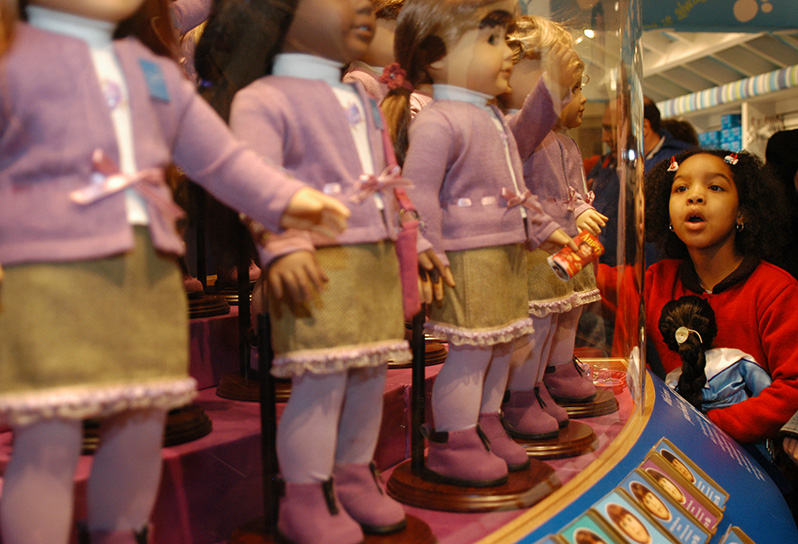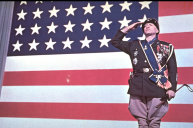If you've been a parent or a child since the early '90s, you're most likely familiar with the American Girl dolls. The dolls each represent a different time in American history and come with their own book series. The books are told from the perspective of the nine-year-old girl protagonist, in an effort to teach young girls about some of the tough topics in our history such as war, racism, slavery, poverty and child abuse.
Pleasant Rowland was a writer and retired teacher from Chicago who created the first three girls in 1986 — Molly, Samantha and Kirsten. The Pleasant Company in Wisconsin first released the 18-inch dolls and their accompanying books with the brilliant idea that children could play out the historical stories while enjoying the dolls. It really was an incredible idea and it paid off big time. Just twelve years later, Mattel Inc. (yep, Barbie's company) purchased American Girl and turned it into an empire.
What started with three main characters and a line of products only available in a catalog has now grown into a major corporation. There are now American Girl Stores in most major cities where you can buy dolls, books and accessories. There's even a restaurant on-site as well as a Doll Hair Salon and Doll Hospital. In addition to the main historical characters, which have been rebranded as "BeForever characters," girls can also make their own lookalike dolls.
Though the initial main characters didn't really include stories past the 1950s, the company has introduced numerous new characters in recent years to capture even more important historical moments in modern history as well as provide more diversity to truly represent all kinds of girls in America. In 2001, the company also launched its "Girl of the Year" dolls in an effort to highlight a diverse set of modern stories each year.
Any time a new character is released, the American Girl staff goes through years of research to make sure that the time period is being properly represented as authentically as possible. An entire team helps with site visits, interviews and fully immerses into the world of each American Girl. Though some have been retired off and on over the years, here are the main historical characters.
1. Samantha Parkington
One of the original dolls, Samantha is an orphan being raised by her grandmother in New York. Set in the Victorian period of the early 1900s, Samantha learns about child labor and classism through her servant friend, Nellie O'Malley, as well as women's suffrage. Samantha even had a film adaptation of her story released in 2004, Samantha: An American Girl Holiday.
2. Josefina Montoya
Josefina is a young Mexican girl living on her family's ranch in New Mexico in the 1820s. One of the focuses of the books is Josefina adjusting to the loss of her mother as well as cultural issues as the U.S. trades with Mexico. It also provides an early perspective of Spanish speaking immigrants and has a glossary in the books to translate words from her Spanish speaking family members.
3. Julie Albright
?Julie was the first girl to come from a divorced family when she was introduced in 2007. Her story is set in San Francisco in the '70s and teaches about the pain of divorce, environmentalism and the disability rights movement. Her best friend is Ivy Ling, a Chinese American girl who even had her own doll as part of the brief "Best Friends" line that would include a doll and an accompanying book told from the perspective of one of the American Girl doll's best friends.
4. Melody Ellison
Melody is one of the more recent additions, introduced to the public in 2016. She was the third Black American Girl doll and her story focused on the Civil Rights Movement in Detroit during the '60s. Melody learns about using her voice to stand up for what is right, joining protests and having courage during this monumental time in American history.
5. Maryellen Larkin
Maryellen was created in 2015 to replace the short-lived Caroline Abbott who had been set during the early 1800s, the daughter of a shipyard owner.
But Maryellen lives in Daytona Beach, Florida during the 1950s. She has big dreams and a wild imagination but tends to get overlooked by her busy family members. She learns about overcoming prejudice in a time focused on conformity, the first trip to Space, the Cold War the stereotyping of women's roles and Polio.
Read More: Radio Flyer: How the Little Red Wagon Became a Classic American Toy
6. Nanea Mitchell
Nanea is a Hawaiin girl living in Honolulu in the '40s during the attack on Pearl Harbor. She learns about what life is like during war time, dealing with loss and how to bring together her community during such a critical time. She also turns to hula dancing as a way to cope with everything around her.
7. Kirsten Larson
Though she was retired in 2010, Kirsten will always be remembered as one of the original dolls. Her family of Swedish immigrants moves to the frontier of the Minnesota Territory in the mid-1800s. Her family adjusts to their new life while still making sure to maintain their Swedish traditions. Kirsten learns about her new language, making friends in her new home, and how life changes when a new baby enters the family.
8. Addy Walker
Introduced in 1993, Addy was the first African American historical doll from the American Girl company. She and her mother were slaves on a North Carolina plantation during the American Civil War, but they escaped to freedom in Philadelphia. Her story is moving and incredibly important for all young girls to read. It teaches young readers about freedom, the horrors of slavery, the importance of family and the reality of racism in our country.
9. Felicity Merriman
Felicity's story takes place during the Revolutionary War where she finds herself in the middle of Patriot and Loyalist sides as her best friend, Elizabeth Cole, lives with a Loyalist family. She loves riding horses, particularly her horse Penny, and is not afraid to stand up for what is right.
10. Molly McIntire
Another original doll, Molly lives in Illinois during World War II. Her father is a doctor stationed abroad in London and her mother works with the Red Cross. She and her siblings are primarily cared for by their housekeeper. She learns about the importance of patriotism, the reality of life during the complications of war, and how important it is for everyone to step up and help. Her best friend Emily Bennett is a British girl who comes to live with the McIntire family to escape the dangers of war at home.
11. Kit Kittredge
Kit represents the challenges of life during the Great Depression. Her best friend Ruthie Smithens is from a wealthy family not affected by the tough times. Kit is a tomboy who loves sports and Amelia Earhart and dreams of becoming a reporter when she grows up. She learns about the importance of supporting your family during hardship — even if it's just helping with chores around the house.
12. Rebecca Rubin
?Rebecca is from a Russian Jewish family who immigrates to New York City in 1914. She learns about what life is like as a first-generation American and wishes to become an actress despite her parents' focus on their traditions. Rebecca grows to understand the importance of celebrating her heritage while also being fascinated by her new home.
13. Kaya
Her full name is Kaya'aton'my (She Who Arranges Rocks). Kaya is the first Native American story in the American Girl world. She is a member of the Nez Perce tribe in what is currently the American Northwest in the 1700s. Though Kaya is brave, she learns that she needs to improve her patience in order to become a leader one day.
In order to properly represent Kaya and her people, American Girl spent five years doing research, which included interviews with tribal chiefs of the Nez Perce and tours of historical sites throughout the land Kaya would be living on.
14. Marie-Grace Gardner and Cécile Rey
Marie-Grace lives in New Orleans during the 1850s. There she becomes best friends with Cécile, the second Black American Girl doll. Their dolls and books were released at the same time in 2011, but they were both retired in 2014. Their stories focus on helping those in need, losing family members and Cécile's French heritage. (A glossary is included at the back of her book.)
Now Watch: 5 Things You Didn't Know About Patsy Cline




